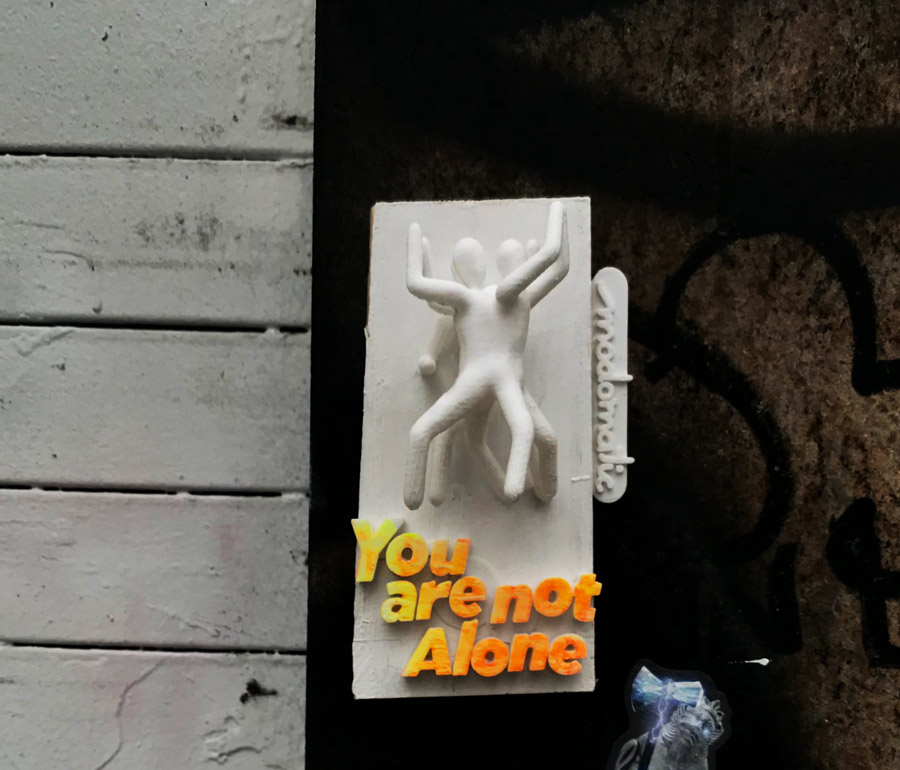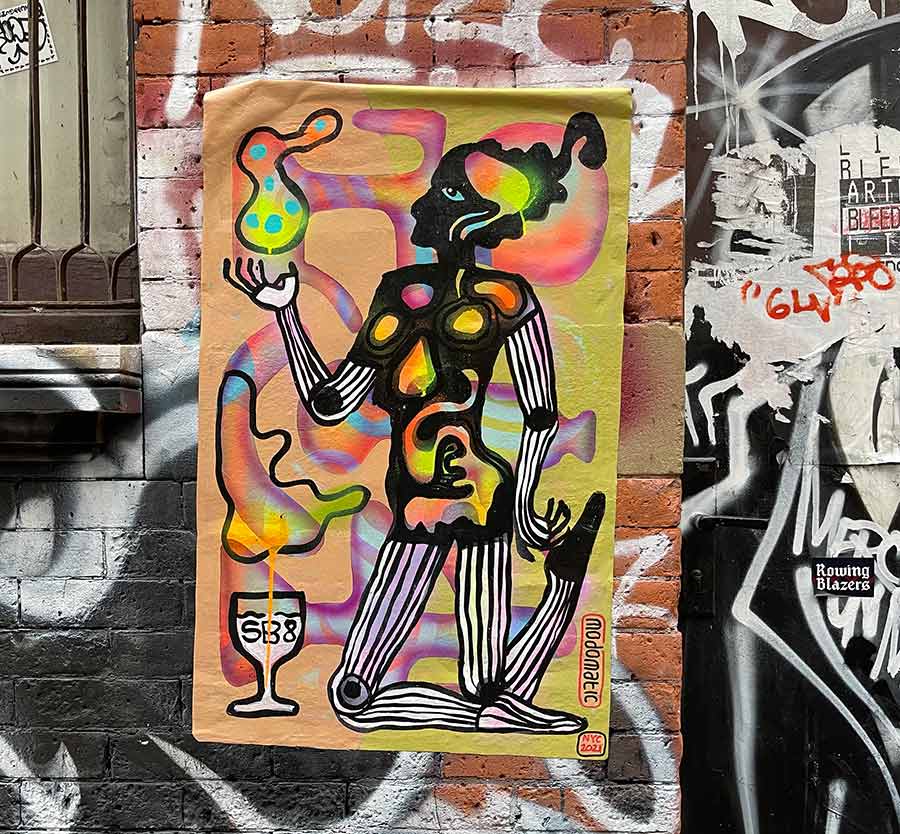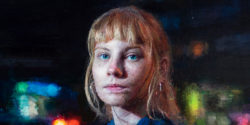Developing a library of personal alphabets, coded symbols, muscle memory and intended meanings.
New York street artist Modomatic is finding his way among a crowded field of new additions to the conversation on the streets. His stylistic leanings are being road-tested, as it were, and he is developing his vocabulary before your eyes. We are pleased to have the opportunity to ask him about his sculptural works, his illustrative/diagrammatic works, and how he finds the space in between worlds that he inhabits to be a street artist in New York today.

BSA: The output on the streets is varied. You have what we think are 3D sculptures, wheat pastes with abstract forms, and a take on the pre-Hispanic codices, etc… Are you one artist with a busy mind or are you a collective of artists?
Modomatic: I’m one artist, with a busy mind and ways to extend working time. I constantly explore different ways of expressing myself and along the way created various forms of art, but basically, they’re all coming out of my imagination and started in my sketchbook. I produced a lot of kinds of work during the pandemic, and now using the street to distribute them, because I can’t keep them all. I used a lot of my existing art. I adjust them for the streets, enhancing them so that they can be viewed a little bit further away. Also, for example, the use of brighter and fluorescent colors. I’m still learning about street art, learning about the culture, the type of artwork, the artists, and the way people are installing their art and where they’re installing it. That actually informs, in a way, how to evolve my art to fit more into the environment and the street culture.

BSA: The 3D sculptures are usually human figures interconnected in dance-like movement. The pieces have words as well and sometimes they feature a staircase. Are the figures dancing? Or preventing each other from falling off the staircase? How do you select the text? Does the text follow the image or is it the opposite?
Modomatic: There are two different series of works on this 3D sculpture. One I called “Chasing the Unicorn.” This one has the stairs with a person (mostly a single person) climbing onto the end of the stairs. Chasing a unicorn for me is almost like you are climbing all the way up to the top at full speed, without knowing really, how far the stairs will go, so reaching the top could also mean reaching the end. I styled it to looked like the person is about to jump or about to, you know, desperately stop from falling.
The second series of 3d sculptures are showing a small crowd of people supporting each other. They are holding each other in a group hug or propping up someone. The messages are positive and supportive of mental health. I am saying that we are not alone and they are aware of the problem and show that there is a willingness of others to help. The 3D people are not originally created for the piece – but they are being used to convey the message. I created the sculpture element for some other projects. As I said before, I have a body of work that I created during the last lockdown and these are the result of one of the experimentations I did with figures. So I created this series.

BSA: The inclusion of the staircase, in particular, is interesting to us. Do you care to elaborate a bit on its symbolism?
Modomatic: For me, the stairs are representing the effort that we take to get somewhere, to reach our goals, whether they are being successful, healthy, wealthy, or just getting out of the holes we are in. Usually, you know exactly the height that you’re going to climb, and what is at the end of it. But sometimes, as depicted in this series, when chasing the unicorn, you just go as fast as you can to climb to the top – not knowing where it ends.
Not knowing how far do you have to go also may mean risking overshooting the stairs. This could happen to us who are trying to get as much as possible, as fast as possible, by any means necessary.

In some pieces, I placed the stairs, upside down. For that moment in time when one is at the end of the stairs, going back down takes as much effort as it was going up.
Positioning yourself in between those times is kind of being invisible. People are going about ending their day, and starting their evening and you are somewhere in between.

BSA: Your wheat-pasted posters have an abstract/mystic aesthetic; with figures, numbers, and words. Is there a secret code to the message?
Modomatic: When I do the sketches, the original drawings, yes. There is some form of messaging that I wanted to get across with the symbols. In the sketchbook, I pretended to create a series of personal alphabets, coded symbols, or simple marks, each with the intended meaning. Then the collection becomes a library, like an icon library. The icons either stay imprinted in my mind, in my sketchbooks or are preserved for my digital work. As I started to produce artwork like posters and other different forms, in 3D or 2D, large or small, I started to use those elements and just basically created the composition.

BSA: We do see an influence from what appear to be Aztec Codex symbols in your work, sometimes mixed with modern war machines. What’s the genesis for this “fusion”?
Modomatic: I’d like to consider myself a collector. I take great pleasure in mixing things I collect to create something new. In creating some of my symbols I used scripts like Hindi, Arabic, Chinese characters, Japanese Hiragana and Katakana, and other ancient scripts. I practice my hand on them, and then at one point, they become just muscle memories. The fusion happens in the process of creation.

BSA: One piece, in particular, resembles the international space station to us, or perhaps a satellite. It also brings to mind Legos. Were you obsessed with Legos? Or maybe still are?
Modomatic: I think you are referring to my series AstroSnout. My kids and I love to play with Legos and other construction toys and their modularity is perhaps carried to these artworks. And recently we’ve been paying a lot of attention to the commercial space industries, with Space X and that sparks our imaginations. I do a lot of my art with my kids, and this is one of our fascinations. You can see that this group of works are more playful.

BSA: Did you like getting up in the streets of NYC during the initial Covid lockdowns when the streets were empty and nobody was around? What pushes you to share your work in the streets?
Modomatic: I get up in the street either early in the evening in the dusk, or early in the morning (5 am) where people are just coming out. I like that it is quiet but it’s not dead quiet. The early evening is when there’s just the confusion of time, between the receding of busy work and the starting of the nightlife. Positioning yourself in between those times is kind of being invisible. People are going about ending their day, and starting their evening and you are somewhere in between.
I share my art on the street because I think that it’s like the best gallery in the city.

You are the artist, you are also the curator, the gallery owner – well not really – but the gallery director and art installer. There’s a lot to figure out; where to put your art, how to position it with other art. I use proximity, as a form of admiration, so sometimes I put my art close to the other artists or work that I admire. I considered light and shadow, especially for the 3D art pieces. I also have to consider the fact that it might be taken down, or covered-up.
I love to find my 3D art has been painted over, finding it become part of the fixtures is my goal. I also love to see it emerging later on when the art covering it has decayed or been removed, and my piece started to reveal itself again.
I don’t hate that sometimes my art is taken away. I’d like to think that somebody liked them, not because they hate them.
I learned that’s the street, and I love that. I appreciate it.




Other Articles You May Like from BSA:
ECB was back on the streets in Bushwick this week doing his portrait of a Moroccan street barber from his series of portraits in Morocco of traders whose trade is in danger of extinction. That i...
Stinging nettle (Urtica dioica) is a staple in herbal medicine and has been since ancient times. Egyptians used stinging nettle to treat arthritis and lower back pain, while Roman troops rubbed it on...
We're back with a slew of new ROA pieces as he continues to share the absolute best images with BSA readers while traveling around the globe. The Belgian street artist, who we refer to as an Urban Nat...
This time of the year, many people become nostalgic, remembering earlier times that seemed simpler, bathed in sepia tones. Walking into the Pop International Gallery a couple of weekends ago – fresh ...
Italian artist John Mayho has been on BSA a couple of times over the years with his commentary about the MOB and a tribute to John Lennon. This weekend he was thinking about another western pop idol w...
 BROOKLYN STREET ART LOVES YOU MORE EVERY DAY
BROOKLYN STREET ART LOVES YOU MORE EVERY DAY










